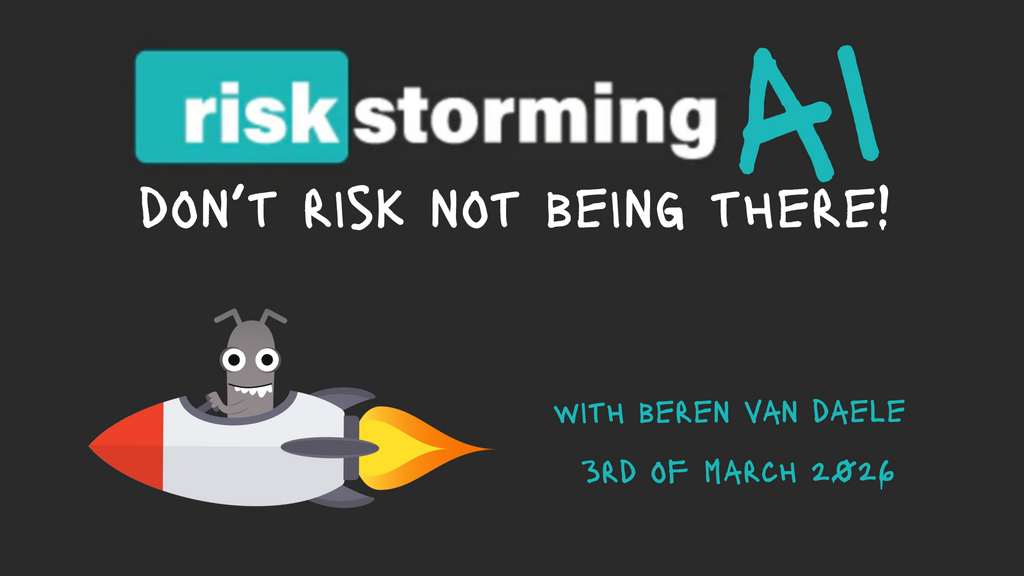I was due to speak at an event but it was delayed 2 months. Although this gave me more time to prepare, it also gave my nerves more time to build up!
I have previously spoken at a small meetup (10 people) and run a workshop for about 20 people, all on the same topic, however that was a while ago and I was nervous for this event - it could be up to 100 people, and no familiar faces in the crowd (some people prefer not to know anyone, however I imagined that a few strangers were cheering me on)
As testers, we are always looking for potential risks with a system or process, how to mitigate these risks and be proactive about resolving them.
I knew I had a great topic for a talk, but wasn’t sure it would be accepted, so the nerves didn’t really kick in until it was confirmed. Whilst battling the nerves I tried to identify what was concerning me - what specifically was I nervous about - what risks was I foreseeing, and how could I attempt to mitigate them, setting myself up for success when delivering the talk.
This is the same approach I took after I had a conference talk accepted at a relatively large conference. I was nervous, but I decided to try and understand why I was nervous and what the risks were. Once I’d done this I could identify a plan to (hopefully!) mitigate and overcome each one.
Risk 1: I will forget what I want to talk about and just stand there silent
Context: Whether it’s in a 1-2-1 at work, a presentation or social event, I think we’ve all experienced our mind going blank - and you’ve possibly seen this happen to someone else too. It’s natural to be anxious/nervous (it’s actually good because it shows you care!), sometimes we need reminders of what we want to say, so I recalled a useful tool from a big meeting at work a few years ago.
Mitigation: Note cards
Notecards are ok: I see many speakers these days confidently speaking without any notecards at all (including but not limited to Jenny Bramble, Vernon Richards, Simon Prior, Jenna Charlton) - either they have rehearsed lots, or their slides are enough of a trigger to remember things, or maybe they aren’t dyslexic like me? I tried running through my presentation without note cards but I couldn’t remember some things that weren’t on the slides (I had lots I wanted to talk about but I just don’t have the memory to recall it all!) With my talk being around accessibility, I didn’t want to have too much stuff on my slides, I wanted the slides to contain enough information without being overwhelming. Also I’ve heard about speakers just reading their slides and it’s not very engaging for the audience at all.
I tried to have key things on my slides, and then when there was something else I was keen to speak about, I wrote it down so there were some triggers (not a script) on some note cards - together with the slides covering the really important things I wanted to speak about. It’s important that the notecards just contain triggers, and not a script, the last thing I wanted was to be reading from the notecards. It was important to number the cards as well, just in case I dropped them, then I knew what order they had to be in!
The aim was I’d still remember some of the extra bits not on the notecards but if nerves took over on the day, they weren’t as critical as what I had written down. I also wrote down ‘slow’ and ‘smile’ as when we’re nervous we can easily forget these! Remember, the audience doesn't know what you wanted to say, so if you forget something, they won’t know!
I truly admire people who don’t need note cards, but I also accept that my brain works differently, and I don’t think anyone in the audience gave 2 hoots that I had notecards.
Risk 2: The audience will be disengaged, not pay attention, or even worse, they may fall asleep.
Context: I knew this topic was interesting to me and some other people, but I couldn’t be sure it would be to the whole audience. Some conferences may have multiple tracks so people are actively selecting to attend your talk. At the conference I was speaking at, I knew there was just one track, so whether they wanted to or not, they were stuck listening to me! In the end there was another track for virtual speakers in the next room, but I planned something to try and reduce the likelihood of disengagement.
Mitigation: Audience engagement - get them involved
Interaction with the audience is good: There are a few ways you can do this - try one, or even, try all of them!
- You could start by checking that everyone can hear you as sometimes the microphone isn’t working properly or you’re too quiet which can mean some people can’t hear you and therefore lose interest right from the start.
- If they seem sleepy, ask them to stand up, stretch and reset. This might be relevant just before or after lunch, or for the first or final talks of the day! Or if you’re feeling really adventurous, get people to dance, like Vernon and Stu did at Test Bash!
- I had planned a couple of activities which people could do alone or chat to the person next to them. I warned them these were coming up in my intro, and the activities gave me a chance to catch my breath, take a sip of water and take in the experience (and check the time if you’re concerned). It wasn’t a vague “what do you think?” interaction but a couple of small activities where they had to assess if something was accessible or not. I made it clear that it was about learning so not to get too bogged down in getting it right. Giving the option to chat to the person next to them or to think alone gave them options depending on what people preferred (think about neurodiverse or shy folk in the audience), and I set a 1 minute timer as that is the time I’d allowed in my practice sessions. I also asked a question about how many people they thought were affected by something in the world. Some shout out, some whisper and some just think and don’t interact (all ok with me) but if you give them some information to base their answer on, you’ll always get someone joining in! You could do a hands up exercise if they’ve experienced something or gauge understanding of your topic before starting.
Whatever engagement activity you choose, try and keep it short, and relevant to your talk if possible. Something memorable is even better!
Risk 3: My nerves will take over and I won’t be very good on the day
Context: I know from some work and social events in the past that I do not feel confident with lots of eyes on me, quite the opposite! Historically it’s made me feel uncomfortable, self conscious and nervous. Planning what we will say or do is a great trick to feel more confident as it’s not unknown content - it may sound obvious - I know from experience that familiarity and lack of unknown are linked to reducing anxiety and nerves.
Mitigation: Rehearse so the content feels more natural and free flowing.
Practising is key: it might sound obvious, but practising is important, and variety in practising helps too. Each run through I did was slightly different but helped me feel more confident with my content and alleviate some nerves. Here are some things I tried:
- Rehearse it alone, with my partner, with some colleagues: (Thanks to Saida, Cheryl and Alison at Bloom & Wild!) - This is also useful for feedback, if there was a spelling mistake or something was not clear, they were on hand to provide that feedback. Sometimes I would look at my slides more than the people, sometimes I would stare at my slides - a balance is ideal!
- Rehearse it sitting, standing, pacing: I wasn’t sure how I’d feel on the day so I tried all of them so I could decide nearer the time. Traditionally people stand still or pace, but with my nerves, I had a chair on stand by incase I needed to sit down! In your rehearsals, see how you feel most comfortable - do you feel like pacing a little will ease your nerves? Will standing still with something to lean on make you feel more confident? You can ask if there will be a lecturn or space to walk around and then practise knowing the limitations/options on the day.
- Rehearse it speaking out loud, running through it in my head, whispering it: Running it through in my head was great sometimes, but of course you can’t do that on the day! Whispering was a great halfway measure when I didn’t feel like speaking loudly! Running it through in my head when I just wanted to reinforce the content in my brain and not practise my delivery, though delivery is key, hence speaking it out loud in practice is important too.
- Rehearse it with my note cards and without them: This was important, especially as I wanted to see what I could remember, and create triggers for other important things on my cards. I had one note card per slide if I needed to recall extra information. You could attach them together (or number them) to prevent potential panic of dropping or muddling them up on the day!
- Rehearse it with a timer and without a timer: I had been asked how long I wanted for my talk and I’d estimated 30 minutes. I thought this would allow for 25 minutes of me speaking and 5 minutes for questions. When I timed my talk, it was pretty consistently around 19 minutes, so I knew with me allowing for a couple of minutes for the audience participation and questions, and hopefully slowing down (thanks to the notecards!) as well (when nervous, many people including me speak quickly!), this was probably ok.
- Pausing during a run through to edit slides or notes, running through without stopping: We’ve all been there, running through our slides and we notice something, sometimes you need to stop and either make a note of something to edit, or actually make the change to your slides or notes, but also you need to practise full run throughs without stopping like you would on the day. Remember the audience doesn't know what you don’t tell them, and no-one is perfect so a small spelling mistake or transition issue is not the end of the world.
- Rehearse it with a clicker and without a clicker: Most of my practices were using the spacebar to trigger my transitions but in my last few practice run throughs, I wanted to check how the clicker worked and how it felt and how to hold that along with my note cards. I borrowed a clicker from my dad, but in the end the venue had their own (it was different shape and size to mine though!)
Risk 4: Another speaker will cover all of my content leaving me nothing to speak about
Context: Whether it’s reading an article which covers the same topic as another, a repeated storyline on TV or your friend telling you the same piece of gossip again, we know that repetition isn’t always exciting. New, fresh, interesting information is more likely to capture our attention. So I was keen to approach my talk content this way too.
Mitigation: Trust the organisers, listen to the other talks and have confidence in your content. Offer a unique insight, talk about your experiences, something no one else can do.
Try not to be concerned about overlapping content with another speaker: When the schedule for the conference was announced, I noticed another speaker on a similar topic. On the original schedule, I was due to speak after this person and was worried I’d spend the break between their talk and mine worrying about how to edit my slides to reduce overlap. When the conference date changed, so did the schedule order and in the end I was first. During the other speakers' talk, they referenced stuff I’d mentioned a couple of times (which was nice), skimmed over a couple of areas that may have overlapped and focused on other areas. Remember, the organisers had set the schedule (and in our case seen our slides), so they knew we weren’t going to be 100% overlapping! Alan Giles spoke after me and did an awesome job. Some tips if you are second, to show you were paying attention and give a nice shout out are::
- Reference or reiterate points from the other talk at relevant points
- Skim over sections that might have been mentioned previously
- Add anecdotes/personal experiences to your talk if you do have to skim over things
There’s no doubt that going second can be challenging, but trust the organisers, and add your own unique spin.
Risk 5: There are many things we cannot control which can affect our delivery and confidence
Such as anxiety on the day, but some we can control, like influencing how the audience might feel whilst listening. I can’t control how well the talk will do and that makes me scared, and I fear I won’t feel confident
Context: If you’re lucky enough to have been able to work from home even 1 day in your career (in these times, who hasn’t?), you’ve likely either been tempted to, or even worked, in your pyjamas. However, I’ve always felt they make me feel tired and want to rest, whereas I want to feel inspired, awake and invigorated in order to do my best when working. I may work in a tracksuit, jeggings and a big cosy jumper, but these items are a mix of comfort but professional ‘enough’ for me to get my work done. This will be different for everyone! Therefore it’s important to be comfortable and confident in your own style.
Mitigation: Focus on what you can control - this can include a drink or snack just before your talk, somewhere quiet to focus and remain calm just beforehand, also pay attention to what you wear as this can be a tool for success when presenting.
Choose an outfit that makes you feel confident: I found out 24 hours before the conference that they were recording it to share later. I panicked as not only did I want to look and feel confident but worried what would look good on camera/video! You don’t want to be adjusting your outfit all the time, or wear an itchy material. You could even rehearse in a few outfits to check you’re comfortable. Think about the potential for the room to be a bit cold or a bit warm and perhaps have an option to cover both. I had some walking in my commute to get there so I wore trainers but then changed into boots for the rest of the day as I felt more confident in them. I ironed my outfit the night before too so I was prepared. It was also raining the day of my talk so it might have been a good idea to pack a spare something in case you get drenched! Luckily the rain wasn’t too bad until after the conference.
For some people, a T-shirt and jeans, like they wear everyday, will be what makes them feel comfortable and confident. For others, maybe a favourite colour, a blazer, a more formal dress or shirt perhaps feels more empowering. Unless there is a dress code, you can wear whatever you like! And like I said, you can change into it specifically for your talk if you want to (Lee Marshall surprised us by changing into a Pirate shirt at TestBash Bucks!).
Speaking in front of people can be scary. I don’t know if it gets less scary the more times you do it (maybe some more experienced speakers can share their experiences), but if you have an important message to share with people, submit your talk and try these tips and who knows, you might quieten your imposter syndrome for a while!
I had some lovely comments directly after, during the lunch break and at the end of the day so I feel like my talk went quite well! Things can always go better or worse but I told myself, if just one person was interested or inspired after my talk, I would feel like I had done well and all the prep was worth it!
If you’d like learn more about here's a link to my Ministry of Testing Accessibility Testing course.






